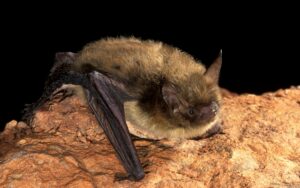By Andrew Berry

Photo credit: J. Scott Altenbach
Please join Bernheim in celebrating 50 years of the Endangered Species Act. On December 28, 1973, the Endangered Species Act was signed into law to recover populations of several of the United States’ iconic wildlife species. The American Alligator and Bald Eagle were two of the original focus species back in 1973 when DDT, habitat loss, and illegal poaching had caused populations to plummet to nearing extinction.
Now at least 1,662 U.S. species and 638 foreign species are protected through the Endangered Species Act, with many added due to population declines from habitat loss and disease. At Bernheim, we currently have 2 bat species on the Federally Endangered Species List including the Indiana Bat and the Northern Long-eared Bat. Gray Bats are listed as a Threatened Species and there are 2 Candidate Species, Tricolored Bat and Little Brown Bat. A ruling is expected soon about the Tricolored Bat status that may declare it as an Endangered Species. These 5 species of bats are at risk of extinction due to habitat loss and an introduced disease called white-nose syndrome.

Photo credit: J. Scott Altenbach
The Monarch Butterfly is a Candidate Species that has seen numbers plummet in the previous decades. Dependent upon milkweed and prairie habitats, they migrate up to 2500 miles to winter in Mexico in the Oyamel Fir forest. Habitat loss, pesticide use, and vulnerability during migration and wintering are thought to be reasons for their decline. Bernheim supports Monarch Butterfly reproduction in our over 300 acres of prairie habitat and is a stopover destination for the many migrants passing through.
Bernheim’s Cedar Grove Wildlife Corridor harbors a small population of Federally Endangered Kentucky Glade Cress, a wildflower endemic (found nowhere else in the world) to limestone cedar glades in Jefferson and Bullitt Counties, KY. Development and loss of cedar glade habitat have taken their toll on this species, with many scattered populations ranking poorly in long-term viability.

Other species at Bernheim have not made it onto the ESA list but can also be considered rare (uncommon), threatened (likely to become endangered), or endangered (immediate risk of extinction). Protections came too late for several species now extinct (gone forever) or extirpated (no longer found) at Bernheim. However, some success has occurred with population increases for the Bald Eagle, now a regular Bernheim Forest visitor. While many species still face growing threats, the protections afforded by the ESA have enabled many species to stave off extinction, expand their populations, and sometimes adapt to our changing landscape.
Bernheim appreciates all the hard work of the United States Fish and Wildlife Service and the many conservationists and biologists who continue to work to recover declining species. Examples of recovery for some species have shown how a collaborative effort is needed from politicians, agencies, professionals, landowners, and recreationists to support biodiversity and species protection.
Below is a list of extinct, extirpated, and endangered species at Bernheim:
Extinct: Passenger Pigeon, Carolina Parakeet
Extirpated: Gray Wolf, Red Wolf, Bison, Elk, Cougar
Current Federally Endangered or Threatened Species: Kentucky Glade Cress, Indiana Bat, Northern Long-eared Bat, Gray Bat
Candidates for Endangered Species Listing: Monarch Butterfly, Tricolored Bat, Little Brown Bat

